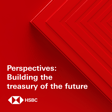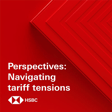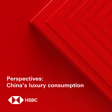Become a Creator today!Start creating today - Share your story with the world!
Start for free
00:00:00
00:00:01

Under the Banyan Tree – China on track to smash its solar goals
With China on course to blast past its green energy goals up to five years early, Fred sits down with Renewables analysts Evan Li and Corey Chan for a broad discussion on the country's rapidly developing solar power industry.Disclaimer: https://www.research.hsbc.com/R/51/dXmTjFz Stay connected and access free to view reports and videos from HSBC Global Research follow us on LinkedIn https://www.linkedin.com/feed/hashtag/hsbcresearch/ or click here: https://www.gbm.hsbc.com/insights/global-research.
Hosted on Acast. See acast.com/privacy for more information.
Transcript
Introduction to Global Energy Insights
00:00:00
Speaker
Welcome to HSBC Global Viewpoint, the podcast series that brings together business leaders and industry experts to explore the latest global insights, trends, and opportunities.
00:00:11
Speaker
Make sure you're subscribed to stay up to date with new episodes.
00:00:14
Speaker
Thanks for listening.
00:00:15
Speaker
And now onto today's show.
00:00:16
Speaker
This is a podcast from HSBC Global Research, available on Apple Podcasts and Spotify.
00:00:22
Speaker
Search for HSBC Global Viewpoint or join us via the HSBC Global Banking and Markets page on LinkedIn.
00:00:29
Speaker
However you're listening, analyst notifications, disclosures and disclaimers must be viewed on the link attached to your media player.
00:00:45
Speaker
Welcome to
China's Solar Power Surge
00:00:46
Speaker
Under the Banyan Tree, where we put Asian markets and economics in context.
00:00:49
Speaker
I'm Fred Newman, chief Asia economist at HSBC.
00:00:52
Speaker
My guests today are Evan Lee, head of energy transition research for Asia Pacific here in Hong Kong, and Corey Chan, head of Asia industrials and renewables research at our mainland Chinese joint venture HSBC Tianhai Securities just over the border.
00:01:07
Speaker
in Shenzhen.
00:01:09
Speaker
On today's show, we're talking China's solar power industry, which has seen both massive rise in output and at the same time a dramatic fall in share prices.
00:01:19
Speaker
Meanwhile, China is on course to blast past its clean energy goals, smashing records in 2023.
00:01:27
Speaker
Stay with us for all the details from HSBC Global Research.
00:01:30
Speaker
This is Under the Banyan Tree.
00:01:37
Speaker
Let's begin with some facts and figures to put the topic in perspective.
00:01:40
Speaker
According to
China's Ambitious Renewable Energy Targets
00:01:41
Speaker
the US-based NGO Global Energy Monitor, China is on track to nearly double its wind and solar capacity by 2025 from today's levels, blowing past the government's official green power target nearly five years early.
00:01:56
Speaker
Back in 2020, President Xi set a goal of 1200 GW of solar and wind capacity by 2030.
00:02:03
Speaker
For context, that's enough to power approximately 900 million homes for a full year.
00:02:09
Speaker
But Global Energy Monitor's report says capacity will be at well over 1300 GW by 2025, not 2030.
00:02:18
Speaker
Meanwhile, on a global level, the International Energy Agency says investments in solar energy in 2023 should surpass spending on oil production for the first time.
00:02:28
Speaker
Let's
China's Solar Investment Impact
00:02:29
Speaker
bring in our experts and dig a little deeper into the China solar story.
00:02:32
Speaker
Evan and Corey, welcome to the podcast.
00:02:34
Speaker
Thank you, Fred.
00:02:35
Speaker
Thank you, Fred.
00:02:36
Speaker
Evan, let me start off with you.
00:02:38
Speaker
These are mind-blowing numbers.
00:02:40
Speaker
China is really planning to invest even more than we thought a couple of years ago.
00:02:46
Speaker
How much money is really being poured into the sector?
00:02:48
Speaker
Give us a sense of the scale of investment that's going in the solar area right now in mainland China.
00:02:55
Speaker
Obviously, we're talking about billions of dollars that's been invested into the space.
00:03:01
Speaker
China is about one third of global solar installation every year.
00:03:08
Speaker
Basically, on the demand side, China would account for about 30 to 40 percent of solar power capacity being installed globally.
00:03:16
Speaker
And seems like the mix is increasingly going to be enlarged as China continue to put more investment into solar.
00:03:24
Speaker
But if we think about on the supply side, China accounts for almost roughly anywhere between 60 to 80 percent of the products along the solar equipment supply chain of the world, meaning that a majority of the solar material wafers and panels that we see today are being manufactured locally in China.
00:03:47
Speaker
So that suggests we couldn't really have a green energy transition without solar panels from mainland China.
Mastery of the Solar Supply Chain
00:03:53
Speaker
Those are impressive statistics on the supply side.
00:03:56
Speaker
Corey, let me bring you in here.
00:03:59
Speaker
Why is it that China is so dominant in terms of the production of solar cells?
00:04:05
Speaker
Have they invented kind of the best technology?
00:04:09
Speaker
Or what accounts for really China's dominance in the global supply chain for solar panels?
00:04:15
Speaker
Firstly, China is dominant along the supply chain.
00:04:19
Speaker
So it accounts for about 90% of global polystream production, 97% of the global wafer production, and almost 75% of the global module production.
00:04:31
Speaker
So from the upstream to downstream, we have already formed a very
00:04:35
Speaker
complete supply chain.
00:04:38
Speaker
And secondly, although there has been some technology which was invented elsewhere globally, it was bringing to China to commercialize, that is to achieve mass production.
00:04:51
Speaker
By achieving mass production, obviously you reduce the cost further.
00:04:55
Speaker
So that's in the last decade, actually the
00:04:58
Speaker
cost of solar has been down by about 90%, mainly because of this ability to commercialize the full supply chain and able to make the solar panels more economic than it was before.
00:05:12
Speaker
So, Corey, you really highlight these in part the economies of scale that drive it down prices.
00:05:18
Speaker
China is a big market and therefore they have huge companies.
00:05:22
Speaker
They're very, very competitive in this space.
00:05:24
Speaker
But let's talk a little bit about China's domestic energy system first.
Solar Energy's Role in China's Power Mix
00:05:29
Speaker
Evan, how important is solar today for China's energy generation domestically?
00:05:36
Speaker
Today, solar is about 7-8% of total power supply.
00:05:43
Speaker
Still quite small, even together with wind, it's roughly about 14-15% of total power supply.
00:05:49
Speaker
Compared to developed markets like Japan, the US, or most parts of Europe, that ratio is still quite small.
00:05:56
Speaker
But just bear in mind that it took about roughly five years to get from 2% to 3% for wind and solar overall to now 14%, 15% in total within a rather short period of time.
00:06:09
Speaker
That's quite impressive.
00:06:11
Speaker
So it's a huge buildup, but it's still not really the bulk of China's energy generation.
00:06:16
Speaker
It's still, you know, but you said 14, 15 percent.
Grid Challenges for Solar Integration
00:06:20
Speaker
Corey, but isn't it true that actually the amount of capacity that we have in China exceeds the actual usage?
00:06:26
Speaker
Because we have a lot of solar panels around, but they're not all hooked up to the grid in China.
00:06:31
Speaker
Yes, that's the case.
00:06:33
Speaker
Actually, if you look at the grid spending, the grid spending hasn't increased as much as the solar installations.
00:06:39
Speaker
So there has been some delay, especially given COVID and some other issues.
00:06:45
Speaker
The grid spending, the increase did not catch up the increase in terms of solar installations.
00:06:50
Speaker
We do expect that that could cause some kind of constraint.
00:06:54
Speaker
It's not just in China, but also the same other part of the world.
00:06:58
Speaker
So when we hear these statistics that by 2025, China will install, you know, another was a 12 1300 gigawatt in solar power, does that mean it's all going to be connected?
00:07:10
Speaker
Or is this just putting it in the desert?
00:07:12
Speaker
And it's not really generating electricity?
00:07:14
Speaker
We think that will be eventually connected.
00:07:16
Speaker
So that means actually you also need to spend more in terms of grid spending.
00:07:20
Speaker
But at the moment, what you just said is true.
00:07:24
Speaker
You know, some solar panels have been put there but not able to connect to the grid.
00:07:30
Speaker
So we're going to see more connection.
00:07:32
Speaker
And Evan, you said we're going to see the share of solar contribution to China's overall energy continue to increase.
00:07:42
Speaker
Now,
Carbon Emission Reduction and Cost Parity
00:07:43
Speaker
in Western economies, we often have people installing solar panels on the roofs, and it's not just a big
00:07:49
Speaker
utility companies are building solar parks, but it's also the average person down the street who's actually building, putting up solar panels.
00:07:57
Speaker
Do we see a similar process in China or is it just giant companies that are setting these massive solar parks?
00:08:03
Speaker
So there are two types of mainstream demand.
00:08:07
Speaker
Obviously, the utilities are building a lot of big-scale solar projects, and that's been very consistent.
00:08:13
Speaker
That investment has been going on for years.
00:08:15
Speaker
But what's been ramping up really quickly over the last year or two is this rooftop applications to both residential and commercial users, putting on solar panels on top of the roof.
00:08:26
Speaker
Just bear in mind, a lot of the people, they don't live in houses, but in apartment buildings.
00:08:33
Speaker
So one of the biggest customers for buying these panels will actually be commercial users, including shopping malls and warehouses, where they could utilize their empty rooftops for solar applications.
00:08:46
Speaker
That power being generated will be for self-use, and extra could be dispatched to the power grid.
00:08:53
Speaker
And where do you see then the share of solar power in overall January usage go over the next few years?
00:08:59
Speaker
You said 14, 15 percent now.
00:09:02
Speaker
Where do we see that go in 2025, 2030?
00:09:04
Speaker
Is it going to be 50 percent as high as that?
00:09:09
Speaker
Just to clarify, the 14-15% is solar and wind combined.
00:09:14
Speaker
Obviously, we do think that renewables, just for solar and wind together, it's going to grow very quickly.
00:09:20
Speaker
And our projection is to hit beyond 20% within the next eight years, and then it will continue to grow onwards.
00:09:29
Speaker
So that is still a massive incremental addition of power in China from renewables.
00:09:37
Speaker
And Corey, China is a trailblazer in many ways for a turn of energy installment.
00:09:43
Speaker
Can you take a step back and just explain to us, you know, what's the overall roadmap that the Chinese government has in mind here?
00:09:52
Speaker
Why this emphasis on this?
00:09:55
Speaker
Is it really to wean the country off of
00:09:58
Speaker
Energy imports, for example.
00:10:00
Speaker
Is it environmental concerns?
00:10:02
Speaker
Is it just the cost efficiency?
00:10:04
Speaker
What's the main thinking behind this massive solar drive and also, I guess, wind drive as well?
00:10:14
Speaker
So first of all, in the long term, there is an ambition of green energy to be integrated with grid to reduce the carbon emissions for the whole country.
00:10:24
Speaker
And secondly, if you look at the sharper reduction of the solar module prices, solar power is currently on parity.
00:10:33
Speaker
with other traditional energy like coal power in China.
00:10:36
Speaker
So actually the economics also makes the solar more attractive comparing with the fossil fuels.
00:10:43
Speaker
So these factors have driven the solar installations in China.
00:10:48
Speaker
Well, this is a great time to take a quick break.
00:10:50
Speaker
And when we'll come back, we're going to ask why Chinese solar share prices have come down and what China's solar transition means for the global energy space.
Global Impact of Solar Overcapacity
00:11:10
Speaker
Corey, this is a big push into solar.
00:11:14
Speaker
We've massive investment coming through in order to realize that.
00:11:17
Speaker
And yet, I'm an economist, but I'm told that the equity prices of these companies that are involved are actually not doing too well.
00:11:25
Speaker
in China overall.
00:11:27
Speaker
The main solar players have seen share prices decline.
00:11:31
Speaker
Can you give us a sense of why is it, Corey?
00:11:33
Speaker
Is it just massive competition and thin margins?
00:11:37
Speaker
Or why are the companies not benefiting necessarily?
00:11:41
Speaker
So first of all, the demand does grow strongly, but what has been growing strongly is also the supply.
00:11:50
Speaker
So the shuffle is mainly due to the issue of overcapacity.
00:11:55
Speaker
So we see that polycylion prices were down by about 70% year-to-date and wafer prices were down by about 40% year-to-date.
00:12:03
Speaker
And in both segments, we see capacity rising meaningfully this year for the whole market.
00:12:10
Speaker
So we've oversupply and that's pushing the squeezing margins of the players.
00:12:15
Speaker
But surely, Evan, that's good for global solar installations.
00:12:19
Speaker
That means there are cheap panels for years to come.
00:12:21
Speaker
And does that mean we're really going to see an acceleration, not just in China, of build-up solar, but really across the world?
00:12:29
Speaker
Because China is such a big supplier of these components.
00:12:32
Speaker
That's exactly what we've been estimating.
00:12:35
Speaker
And further to what Corey explained, the cost of solar has gone down quite a lot.
00:12:41
Speaker
Over the last 10 years, it's gone down 90%.
00:12:44
Speaker
And with that much capacity in the system, we do believe that the cost overall will continue to drop.
00:12:51
Speaker
And it's more competitive against traditional energy, including coal, oil, and gas.
00:12:57
Speaker
So you're quite right, because not just China is adding a lot of solar panels.
00:13:02
Speaker
Globally, we're seeing Europe and the US going on acceleration on the renewable energy capacity growth, as well as a lot of emerging markets, including South America and Africa as well.
00:13:14
Speaker
That's obviously tremendous news from an environmental standpoint.
00:13:18
Speaker
Corey, can I just ask you, you're very close to the industry.
00:13:21
Speaker
Are there also improvements in technology that we can expect?
00:13:25
Speaker
So we have cheap panels coming out, we can install them, but surely we're not at the end of the journey in terms of technology improvements.
00:13:33
Speaker
Maybe these panels will get even more efficient over time?
00:13:36
Speaker
Yes, you are very right.
00:13:38
Speaker
Efficiency for those solar cells is also increasing over time.
00:13:43
Speaker
Currently, we are in the process of switching from the old generation of cell technology to the new generation of cell technology.
00:13:51
Speaker
So that means on average, the solar panels can generate about 3 to 5% more power versus solar panels that are put into place one to two years ago.
00:14:03
Speaker
So if this kind of efficiency improvement continues, basically you don't need to spend further on the same product, but you can have 10%, 20% higher power generation from the solar panels in place.
00:14:17
Speaker
So that will effectively reduce the cost per kilowatt hour basis will be much lower.
00:14:24
Speaker
Well, gentlemen, this is an absolutely breathtaking development in the solar industry.
00:14:30
Speaker
China is leading really the world in this.
00:14:33
Speaker
And China's own investment is benefiting really the rest of the world through the decline in prices and the cheap panels that are really available.
00:14:44
Speaker
But Evan, one last question for you.
00:14:45
Speaker
We're installing all this capacity, but we're still left with the problem of storage, don't we?
00:14:51
Speaker
The
The Future of Solar: Storage Solutions
00:14:52
Speaker
sun doesn't shine 24 hours a day.
00:14:55
Speaker
Do you see advances there coming through?
00:14:57
Speaker
What are the preferred solutions?
00:14:59
Speaker
Do we have new batteries coming online?
00:15:01
Speaker
Or what do you count on to leverage that solar generation?
00:15:08
Speaker
You're quite right because we've been talking about energy transition quite a lot for the last three years, ever since obviously China and the rest of the world has been setting these big targets for carbon neutrality.
00:15:18
Speaker
But one of the biggest enablers, as we do see now, is storage, as you mentioned.
00:15:22
Speaker
So without proper energy storage, basically you can't really make use of solar panels during nighttime where there's no sunshine.
00:15:31
Speaker
So the investment going into storage is also in even greater acceleration, as we do see.
00:15:39
Speaker
In our view, the game for storage is still catching up, and we just hope that it could catch up quick enough so that they could enable us to get to the renewable energy capacity targets as we want them to be in by 2030, 2050.
00:15:55
Speaker
Well, that reminds us plenty to do.
00:15:57
Speaker
We have obviously made enormous strides in solar energy, but obviously it's a much more complex issue to rewire the global energy system.
00:16:07
Speaker
But it sounds like we're well on the way.
00:16:09
Speaker
So thank you, Corey and Evan, for joining us under the Banyan tree and hope to bring you back in the near future to talk again about some of the latest developments in China's solar market.
00:16:20
Speaker
Thank you.
00:16:20
Speaker
Thank you, Fred.
00:16:21
Speaker
Thank you, Fred.
00:16:27
Speaker
And that brings us to the end of today's podcast.
00:16:29
Speaker
Many thanks for listening.
00:16:30
Speaker
And if you're a global research client, do check out both Evans and Corey's latest reports on solar in China and the wider Asia region.
00:16:37
Speaker
Both reports were published this week alongside the global solar thematic report from Sean McLaughlin, who heads our industrial team in London.
00:16:44
Speaker
That's it from all of us here in the Banyan Tree.
00:16:46
Speaker
We'll talk to you again next week.
00:16:50
Speaker
Thank you for joining us at HSBC Global Viewpoint.
00:16:53
Speaker
We hope you enjoyed the discussion.
00:16:55
Speaker
Make sure you're subscribed to stay up to date with new episodes.

















